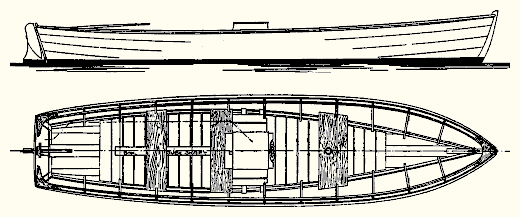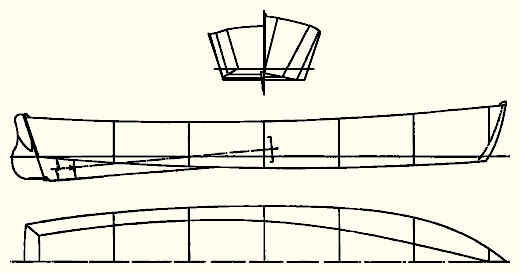

Our latest design of a low-powered reasonably fast flat bottom boat should be of special interest to the amateur boat builder, or for that matter, the average independent builder of small boats. The form of the hull is such that the construction is about as simple as is possible and yet be a shapely boat. It is a hull which can be completely built without the service of a steam box, or a shop full of costly tools.

This design shows a 19 foot 2 inch overall, 18 foot waterline, 4 foot 4 inch beam, and 1 foot draft flat bottom skiff-type utility boat. The freeboard at the bow is 2 feet 1 inch, at the stern 1 foot 7 inches and at the lowest place in the sheer, 1 foot 5 inches. The plans show a single cylinder 6 h.p. Baby Huskie Palmer motor. With this or another motor of similar characteristics the speed of this latest of MoToR BoatinG's fleet of useful boats will be 13.5 miles an hour.
As time unfolds, motor boats of much less breadth in proportion to length than those now in the mode will become common. Among the reasons for this switch from broad beam to narrow beam will be: with equal displacement and power the narrow beam boat will be the faster of the two; for equal displacement the slim-lined hull will be the easiest of the two models to build, and therefore the cheapest; in general use, providing the design is properly made, the easy-lined narrow boat will behave best in rough water, it will throw far less spray and water, handle better in a following sea, and when slowed down, will not pound, and therefore be more comfortable than any of its two-and-a-half to three-beam sisters. Yes, Shipmates, there is a great deal to be said for the performance of reasonably narrow round bottom, V bottom, and flat bottomed boats; slim ladies that go about their work without fuss and lather; neat sisters that deserve the name of excellency.

The lines show a hull having straight sections throughout. There is generous flare in the topsides for the full length of the boat. The flare increases as the sections approach the bow. The widest point of the bottom measures 3 feet 6 inches, the width of the bottom at the stern is slightly more than 2 feet, and at station 2 the breadth of the bottom is a scant 18 inches. The fore and aft lines are long and easy and designed for a minimum of resistance for speeds of from 7 to 14 miles an hour. The skiff should not be over-powered.